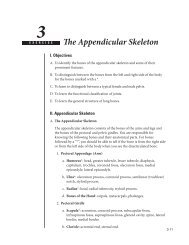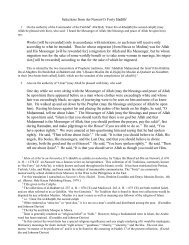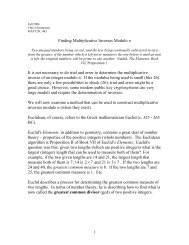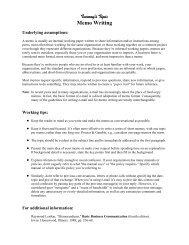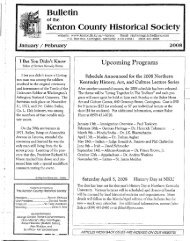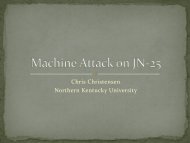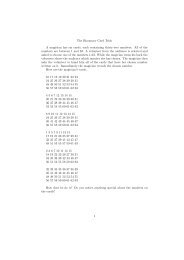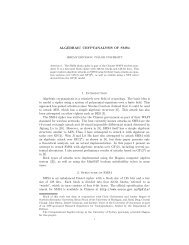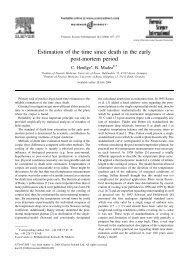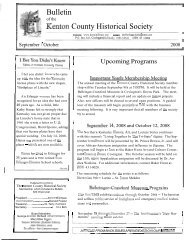Dr. Wendy Knepper Harvard University Email: wknepper@gmx.de ...
Dr. Wendy Knepper Harvard University Email: wknepper@gmx.de ...
Dr. Wendy Knepper Harvard University Email: wknepper@gmx.de ...
Create successful ePaper yourself
Turn your PDF publications into a flip-book with our unique Google optimized e-Paper software.
Perceval, the errant knight: romancing the rhizome<br />
<strong>Wendy</strong> <strong>Knepper</strong> (<strong>Harvard</strong> <strong>University</strong>)<br />
<strong>Dr</strong>. <strong>Wendy</strong> <strong>Knepper</strong><br />
<strong>Harvard</strong> <strong>University</strong><br />
<strong>Email</strong>: <strong>wknepper@gmx</strong>.<strong>de</strong><br />
Recently, Gilles Delueze and Felix Guattari’s figure of the rhizome has been applied to narrative<br />
structures. Janet H. Murray suggests that rhizome narratives consist of many stories, thus<br />
un<strong>de</strong>rmining the sense of a dominant structure or closure. 1 Similarly, Wolfgang Kraus remarks<br />
that rhizome stories “can be easily changed, retold, <strong>de</strong>- and reconstructed and are thus open to<br />
the future.” 2 According to Kraus, rhizome stories “show a narrator erring around in his story,<br />
"failing" on the coherent organisation of the telling and never succeeding in getting hold of a<br />
coherent agent in this multithrea<strong>de</strong>d story-web.” 3 In this paper, which is part of a longer study on<br />
grail narratives, I will focus on two of the “roots” of the Perceval story, Chretien <strong>de</strong> Troyes’<br />
incomplete Le Conte du Graal (Perceval) and Wolfram von Eschenbach’s Parzifal, <strong>de</strong>monstrating<br />
how each functions as a rhizome story as well as part of a dispersed rhizomatic network of grail<br />
narratives. The role of erring, as the act of wan<strong>de</strong>ring and making a mistake, will be examined in<br />
the context of the errant-knight, the errant-narrator and the errant narrative.<br />
In my comparative analysis of these texts, I will focus on the following aspects of the romance as<br />
a rhizome story:<br />
1. Quite literally, Perceval is the exemplar of the errant knight, a figure whose wan<strong>de</strong>ring quests<br />
are driven by the errors he commits, and whose errors drive him to err further. As his quest<br />
for the grail <strong>de</strong>monstrates, error leads to <strong>de</strong>lay, even <strong>de</strong>ferring the possibility of ever<br />
completing the quest. Error, in turn, also produces further erring as a proliferate number of<br />
participants are called upon to fulfill the quest for the grail, thus renewing and further<br />
dispersing the quest. Perceval, the errant knight, produces an errant quest, open to all.<br />
2. The metanarrative is figured as a rhizome. The characteristics of Perceval’s errant course,<br />
<strong>de</strong>lay, <strong>de</strong>ferral, proliferation and renewal, are also those of the rhizome as <strong>de</strong>fined by Felix<br />
Guattari and Gilles Deleuze. The rhizome, a plant capable of multiplying itself from multiple<br />
sources, suggests a non-hierarchical network: “In contrast to centered (even polycentric)<br />
systems with hierarchical mo<strong>de</strong>s of communication and preestablished paths, the rhizome is<br />
an acentered, nonhierarchical, nonsignifying system with a General and without an<br />
organizing memory or central automation, <strong>de</strong>fined solely by a circulation of states". 4 Although<br />
their strategies differ, I will explore how voices of the narrator in Chretien and Eschenbach<br />
prompt the rea<strong>de</strong>r to imagine the text as an errant structure, a narrative that has “gone off<br />
course” (i.e. reference to sources, references to other narratives, introduction of multiple<br />
characters who acenter the narrative, fragmentation, multiple frames of interpretation,<br />
multiple concepts of power, mirrored figures, etc).<br />
3. What is the role of errancy? In what ways do Eschenbach and Chretien both create<br />
narratives that fail to cohere or lend themselves to closure? In what way is the errant-narrator<br />
a double for the errant-knight?<br />
4. In the romance, the Grail functions as a rhizome. It is an object of shifting significance and<br />
form, thus in<strong>de</strong>terminate, open to subsequent interpretation: the product and source of<br />
1<br />
Janet H. Murray, Hamlet on the Holo<strong>de</strong>ck: The future of narrative in cyberspace (Cambridge:<br />
MIT Press, 1999): 132.<br />
2 nd<br />
Wolfgang Kraus, “The construction of belonging in post-mo<strong>de</strong>rn times,” 2 International<br />
Conference on the Dialogical Self (Ghent, Belgium, October 2003): 6.<br />
3<br />
Ibid.<br />
4<br />
Felix Guattari and Gilles Deleuze, A Thousand Plateaus. Trans. Brian Massumi. Minneapolis: U<br />
of Minnesota Press, 1987, 21.<br />
1
<strong>Dr</strong>. <strong>Wendy</strong> <strong>Knepper</strong><br />
<strong>Harvard</strong> <strong>University</strong><br />
<strong>Email</strong>: <strong>wknepper@gmx</strong>.<strong>de</strong><br />
multiple histories and genealogies. In the two romances to be discussed, it is placed in a<br />
variety of contexts, situated among Celtic, Christian and Muslim interpretations of its<br />
meaning. Thus, it too can be interpreted as a rhizome. As such, it is both a benign and a<br />
potentially lethal force, at the root of a number of subversive effects in various kingdoms,<br />
most notably that of Arthur.<br />
5. In the canon, the Grail functions as a rhizome story. The Grail is open to ongoing retellings,<br />
<strong>de</strong>constructions and reconstructions, all of which have continued for well over eight centuries.<br />
Within the canon, the quest for the grail is open, ongoing and subject to reinterpretation, a<br />
possibility enabled by its mysterious, open signification. How does such interpretation change<br />
our reading of the canon?<br />
6. Finally, it is perhaps the very possibility of the grail as a rhizome/rhizome story that<br />
challenges the Arthurian ten<strong>de</strong>ncy to rootedness, to the notion of a central kingdom and king.<br />
The figure of Arthur is dispersed by the grail quest, subject to affiliation with Christ, the Fisher<br />
King and hope of a ruler to come. The “once and future king” is acentered and transformed<br />
into the one and the many: a figure whose i<strong>de</strong>ntity is subject to ongoing exploration, thus<br />
enabling writers and rea<strong>de</strong>rs to err in searching for the grail quest and to err as well through<br />
the field of the Arthurian genre. To what extent do the “errancy” of the grail legend and the<br />
tale of Perceval subvert or transform the Arthurian genre?<br />
2



